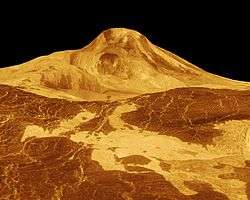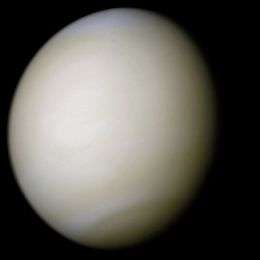List of missions to Venus
This is a list of space missions to the planet Venus. Missions to Venus constitute part of the exploration of Venus.
List
As of 2013, the Soviet Union, United States, European Space Agency and Japan have conducted missions to Venus.
| Spacecraft | Launch date[1] | Operator | Mission | Outcome | Remarks | Carrier rocket[2] |
|---|---|---|---|---|---|---|
| Tyazhely Sputnik (1VA No.1) |
4 February 1961 | OKB-1 Soviet Union |
Impactor[3] | 0Launch failure | Power transformer failure, upper stage failed to ignite, never left LEO[3] | Molniya |
| Venera 1 (1VA No.2) |
12 February 1961 | OKB-1 Soviet Union |
Impactor[3] | 1Spacecraft failure | Communications failure. Flyby on 19 May 1961 at less than 100,000 kilometres (62,000 mi); no data returned | Molniya |
| Mariner 1 (P-37) |
22 July 1962 | NASA United States |
Flyby | 0Launch failure | Failed to orbit; destroyed by range safety following guidance failure[4] | Atlas-Agena BAtlas-LV3 Agena-B |
| 2MV-1 No.1 | 25 August 1962 | OKB-1 Soviet Union |
Lander | 0Launch failure | Premature upper stage cutoff due to ullage motor malfunction; never left LEO[4] | Molniya |
| Mariner 2 (P-38) |
27 August 1962 | NASA United States |
Flyby | 4Successful | Flyby on 14 December 1962 | Atlas-Agena BAtlas-LV3 Agena-B |
| 2MV-1 No.2 | 1 September 1962 | OKB-1 Soviet Union |
Lander | 0Launch failure | Upper stage fuel valve failed to open, resulting in failure to ignite; never left LEO[4] | Molniya |
| 2MV-2 No.1 | 12 September 1962 | OKB-1 Soviet Union |
Flyby | 0Launch failure | Anomalous third stage cutoff resulted in air bubbles forming in fourth stage fuel; fourth stage shut down less than a second after ignition; failed to leave LEO[4] | Molniya |
| 3MV-1 No.2 | 19 February 1964 | OKB-1 Soviet Union |
Flyby | 0Launch failure | Third stage oxidiser leak caused propellant to freeze in feed lines, which subsequently cracked; failed to orbit[5] | Molniya-M |
| Kosmos 27 (3MV-1 No.3) |
27 March 1964 | OKB-1 Soviet Union |
Flyby/Lander | 0Launch failure | Upper stage attitude control failure, never left LEO[5] | Molniya-M |
| Zond 1 (3MV-1 No.4) |
2 April 1964 | OKB-1 Soviet Union |
Flyby/Lander | 1Spacecraft failure | Electronics shorted out, communications lost before flyby.[5] Flew past Venus on 14 July 1964. | Molniya-M |
| Venera 2 (3MV-4 No.4) |
12 November 1965 | OKB-1 Soviet Union |
Flyby | 1Spacecraft failure | Flew past Venus on 27 February 1966, closest approach at 02:52 UTC. Communications lost after flyby, before any data could be returned.[6] | Molniya-M |
| Venera 3 (3MV-3 No.1) |
16 November 1965 | OKB-1 Soviet Union |
Lander | 1Spacecraft failure | Communications lost as soon as spacecraft entered atmosphere on 1 March 1966, no data returned. | Molniya-M |
| Kosmos 96 (3MV-4 No.6) |
23 November 1965 | OKB-1 Soviet Union |
Flyby | 0Launch failure | Third stage combustion chamber exploded, resulting in loss of control, upper stage failed to ignite; Never left LEO[6] | Molniya-M |
| Venera 4 (4V-1 No.310) |
12 June 1967 | Lavochkin Soviet Union |
Lander | 2Partial failure | Returned atmospheric data during entry on 18 October 1967 but failed to reach surface intact[7] | Molniya-M |
| Mariner 5 | 14 June 1967 | NASA United States |
Flyby | 4Successful | Flyby on 19 October 1967, closest approach at 17:34:56 UTC[7] | Atlas-Agena DAtlas SLV-3 Agena-D |
| Kosmos 167 (4V-1 No.311) |
17 June 1967 | Lavochkin Soviet Union |
Lander | 0Launch failure | Upper stage failed to ignite; turbopump cooling malfunction. Never left LEO[7] | Molniya-M |
| Venera 5 (4V-1 No.330) |
5 January 1969 | Lavochkin Soviet Union |
Atmospheric | 4Successful | Entered atmosphere on 16 May 1969, operated for 53 minutes | Molniya-M |
| Venera 6 (4V-1 No.331) |
10 January 1969 | Lavochkin Soviet Union |
Atmospheric | 4Successful | Entered atmosphere on 17 May 1969, operated for 51 minutes | Molniya-M |
| Venera 7 (4V-1 No.630) |
17 August 1970 | Lavochkin Soviet Union |
Lander | 2Partial failure | Landed at 05:37:10 UTC on 15 December 1970, rolled upon landing and returned severely limited data | Molniya-M |
| Kosmos 359 (4V-1 No.631) |
22 August 1970 | Lavochkin Soviet Union |
Lander | 0Launch failure | Never left LEO | Molniya-M |
| Venera 8 (4V-1 No.670) |
27 March 1972 | Lavochkin Soviet Union |
Lander | 4Successful | Landed at 09:32 UTC on 22 July 1972 | Molniya-M |
| Kosmos 482 (4V-1 No.671) |
31 March 1972 | Lavochkin Soviet Union |
Lander | 0Launch failure | Never left LEO | Molniya-M |
| Mariner 10 | 3 November 1973 | NASA United States |
Flyby | 4Successful | Flyby on 4 February 1974; closest approach at 17:01 UTC; observed Venus and performed gravity assist to reach Mercury | Atlas-Centaur D1AAtlas SLV-3D Centaur-D1A |
| Venera 9 (4V-1 No.660) |
8 June 1975 | Lavochkin Soviet Union |
Lander/OOrbiter/Lander | 4Successful | Entered orbit on 20 October 1975; lander landed at 05:13 UTC on 22 October | Proton-K/D |
| Venera 10 (4V-1 No.661) |
14 June 1975 | Lavochkin Soviet Union |
Lander/OOrbiter/Lander | 4Successful | Entered orbit on 23 October 1975; lander landed at 05:17 UTC on 25 October | Proton-K/D |
| Venera 11 (4V-1 No.360) |
9 September 1978 | Lavochkin Soviet Union |
Lander/FFlyby/Lander | 3Mostly successful | Flyby on 25 December; Lander landed at 03:24 UTC the same day. Multiple instrument failures on lander | Proton-K/D-1 |
| Venera 12 (4V-1 No.361) |
14 September 1978 | Lavochkin Soviet Union |
Lander/FFlyby/Lander | 3Mostly successful | Lander landed at 03:20 UTC on 21 December 1975. Both cameras on lander failed | Proton-K/D-1 |
| Pioneer Venus 1 (PV Orbiter) |
20 May 1978 | NASA United States |
Orbiter | 4Successful | Entered orbit on 4 December 1978, decayed on 22 October 1992 | Atlas-Centaur D1ARAtlas SLV-3D Centaur-D1AR |
| Pioneer Venus 2 (PV Multiprobe) |
8 August 1978 | NASA United States |
Atmospheric | 4Successful | Entered the atmosphere on 4 December 1978; consisted of five spacecraft, one of which briefly continued transmitting after reaching the surface | Atlas-Centaur D1ARAtlas SLV-3D Centaur-D1AR |
| Venera 13 (4V-1M No.760) |
30 October 1981 | Lavochkin Soviet Union |
Lander/FFlyby/Lander | 4Successful | Lander landed at 03:20 UTC on 1 March 1982. | Proton-K/D-1 |
| Venera 14 (4V-1M No.761) |
4 November 1981 | Lavochkin Soviet Union |
Lander/FFlyby/Lander | 4Successful | Lander landed on 5 March 1982. | Proton-K/D-1 |
| Venera 15 (4V-2 No.860) |
2 June 1983 | Lavochkin Soviet Union |
Orbiter | 4Successful | Entered orbit 10 October 1983, operated until July 1984 | Proton-K/D-1 |
| Venera 16 (4V-2 No.861) |
7 June 1983 | Lavochkin Soviet Union |
Orbiter | 4Successful | Entered orbit 11 October 1983, operated until July 1984 | Proton-K/D-1 |
| Vega 1 (5VK No.901) |
15 December 1984 | Lavochkin Soviet Union |
Lander/FAFlyby/Atmospheric/Lander | 3Mostly successful | Landed 11 June 1985. Atmospheric probe deployed during entry operated for two days. Main bus continued to explore comet 1P/Halley | Proton-K/D-1 |
| Vega 2 (5VK No.902) |
21 December 1984 | Lavochkin Soviet Union |
Lander/FAFlyby/Atmospheric/Lander | 4Successful | Landed 15 June 1985. Atmospheric probe deployed during entry operated for two days. Main bus continued to explore comet 1P/Halley | Proton-K/D-1 |
| Magellan | 4 May 1989 | NASA United States |
Orbiter | 4Successful | Entered orbit 10 October 1990, deorbited 13 October 1994 | Space Shuttle Atlantis STS-30 / IUS |
| Galileo | 18 October 1989 | NASA United States |
Gravity assist | N/A | Flyby on 10 February 1990 en route to Jupiter | Space Shuttle Atlantis STS-34 / IUS |
| Cassini | 15 October 1997 | NASA United States |
Gravity assist | N/A | Flybys on 26 April 1998 and 24 June 1999 en route to Saturn | Titan IV(401)B |
| MESSENGER | 3 August 2004 | NASA United States |
Gravity assist | N/A | Flybys on 24 October 2006 and 5 June 2007 en route to Mercury | Delta II 7925H |
| Venus Express | 9 November 2005 | ESA Europe |
Orbiter | 5Successful | Entered orbit 11 April 2006. Full communications lost on the 28th of November 2014 [8] | Soyuz-FG/Fregat |
| Akatsuki | 20 May 2010 | JAXA Japan |
Orbiter | 5Successful on second attempt | Flew past Venus on 6 December 2010 after failing to enter orbit. Insertion was successfully reattempted on 7 December 2015. | H-IIA 202 |
| IKAROS | 20 May 2010 | JAXA Japan |
Flyby | 4Successful | Experimental solar sail. Flew past Venus on 8 December 2010 | H-IIA 202 |
| Shin'en | 20 May 2010 | UNISEC Japan |
Flyby | 1Spacecraft failure | Communications never established after launch. Flew past Venus in December 2010 | H-IIA 202 |
References
- ↑ McDowell, Jonathan. "Launch Log". Jonathan's Space Page. Retrieved 21 January 2013.
- ↑ Krebs, Gunter. "Interplanetary Probes". Gunter's Space Page. Retrieved 21 January 2013.
- 1 2 3 Siddiqi, Asif A. (2002). "1961". Deep Space Chronicle: A Chronology of Deep Space and Planetary Probes 1958-2000 (PDF). Monographs in Aerospace History, No. 24. NASA History Office. pp. 29–32.
- 1 2 3 4 Siddiqi, Asif A. (2002). "1962". Deep Space Chronicle: A Chronology of Deep Space and Planetary Probes 1958-2000 (PDF). Monographs in Aerospace History, No. 24. NASA History Office. pp. 34–37.
- 1 2 3 Siddiqi, Asif A. (2002). "1964". Deep Space Chronicle: A Chronology of Deep Space and Planetary Probes 1958-2000 (PDF). Monographs in Aerospace History, No. 24. NASA History Office. pp. 41–45.
- 1 2 Siddiqi, Asif A. (2002). "1965". Deep Space Chronicle: A Chronology of Deep Space and Planetary Probes 1958-2000 (PDF). Monographs in Aerospace History, No. 24. NASA History Office. pp. 47–52.
- 1 2 3 Siddiqi, Asif A. (2002). "1967". Deep Space Chronicle: A Chronology of Deep Space and Planetary Probes 1958-2000 (PDF). Monographs in Aerospace History, No. 24. NASA History Office. pp. 61–68.
- ↑ http://sci.esa.int/venus-express/55141-venus-express-goes-gently-into-the-night/
External links
- Popular Science - February 2003 - Is There Life on Venus? (Google Books link)
This article is issued from Wikipedia - version of the 11/14/2016. The text is available under the Creative Commons Attribution/Share Alike but additional terms may apply for the media files.



